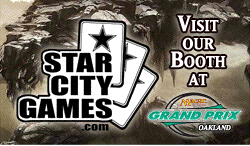Warning: Spoilers!
While Worldwake spoiler season was slow to start, it seems that it has totally blasted off. I have to admit, I was a little skeptical, as the few spoilers we had looked decent, but I was not particularly inspired. This past week has changed all that. To say that I am excited to be gunslinging the Sun Mesa Events prerelease in LA this weekend would be an understatement. I am so excited to draft this set, to start building Standard decks, and to incorporate new technology into older formats. This set is shaping up incredibly well.
Before we dive into the cards I want to discuss today, there are a few things I would like to mention. First of all, big thanks to GatheringMagic.com and MTGSalvation.com for the spoiler data. If I do not explicitly state that a card is confirmed or show an actual card image, take it to mean that it is a probable and credible rumor, but not set in stone.
In addition, I currently do not think that Worldwake will sell like M10 or Zendikar. However, I think it will sell very well, and could sell out again (if it has not already). If it does, you better believe the box price will climb again. I am not expressing any guarantee as to the change of price of Worldwake; all I am saying is that I said the same thing about M10 and Zendikar, and people have written me enough thank you letters to suggest that people appreciate this sort of “tip.” It may not match M10 and Zendikar (it is a small set), but I think there is a very reasonable chance this one sells out.
Okay, let’s get down to business!
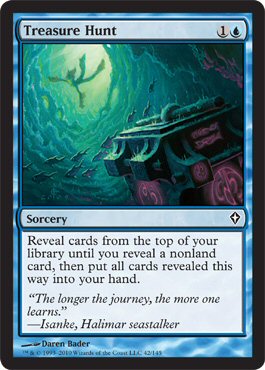
“Blue is back! This card single-handedly makes me want to get back on the train,” says Mark Herberholz of Treasure Hunt, as reported by Brian David-Marshall.
Is Mark perhaps going a little overboard? Is he really just that desperate for card draw? How good is Treasure Hunt anyway? You never draw more than one spell…
What is my take on Treasure Hunt?
Ken Nagle (Worldwake lead designer), you just stole my heart! Treasure Hunt is the Chosen One, here to lead us to the Promised Land. Treasure Hunt is one we have been waiting for. This card is the Great Blue Hope, it is the cheap library manipulation that the prophets have spoken of for so long.
Remember that Impulse I wanted? I guess they did me one better. Treasure Hunt is not only incredibly powerful, I think it is incredibly fascinating and there is so much to talk about on the subject. Unfortunately, I felt the same way about Bloodbraid Elf. I truly hope that Treasure Hunt does not go the same way that one did. I suspect there is a very good chance that Treasure Hunt will turn out to be like Thawing Glaciers, where it is totally the best and wins over and over, but most people don’t see it beat them so they don’t grow to hate it so (as opposed to Bloodbraid Elf, which looks like it beats you whenever it beats you). Still, we could just sit here hyperbolically pondering out fortune, or…
“You know what I like? Math.”
Brian Hacker
Just how many cards on the average does Treasure Hunt draw? Well, I could show you some big long mathematical proof (which I painstaking demonstrated to Michael Jacob a couple days ago), or I could just cut to the chase and tell you the shortcut.
In general, Treasure Hunt draws you L/S + 1 cards, where L= number of lands still in your library (or total, to save time) and S= Spells (all non-lands). So, if you are playing a deck that is 26 lands and 34 spells, assuming the cards you have drawn so far are random, than Treasure Hunt will on the average draw 1.75 cards. Before we get into discussing what it means to draw 1.75 cards, let me show you a simple demonstration of why this is essentially true.
Let’s say it is turn 2. You are on the play and have seen 8 cards so far. An average of almost 3.5 of these are lands, 4.5 are spells. If you cast Treasure Hunt in this position, you have an average of 22.5 land in your 52 card deck.
It is like you are playing a gambling game where you get to “roll dice” to see if you win a bonus card and get to roll again. Each time you roll, your chances to “win” are proportionate to your mana ration. Each time you win, you get to roll again. When you lose, you always get an extra card.
In every scenario, you get at least 1 card, including when you lose out the gate, so you have +1.0 equity from that. You will reveal a land (which means an extra card) on the first flip 0.44 of the time, so you have +0.44 to your equity from that. You will reveal a land each of your first two 0.19 of the time, which adds +0.19 to your expected value. The chances of the first three all being land are 0.08 (or 8%) of the time, so you get +0.08 there. As you can imagine, this continues, with four lands coming up 0.03% and five lands coming up 0.01% each time, adding this equity to your play.
What do I mean by equity? I mean how many cards you are mathematically expected to draw, which in this case is highly variable (in any given moment, you may have no idea how many cards you’ll draw) but extremely predictable (if you don’t manipulate your library, you could do this 1000 times and be pretty sure you will end up drawing very nearly 1756 cards, plus or minus a couple dozen).
Okay, so this thing supposedly draws 1.75 cards? Aren’t they a disproportionate amount of land? I don’t want a million lands in my hands. Divination has a very good chance of drawing two spells, yet this thing never does. How do we evaluate how many cards we are really getting off of this?
Here is a fact that is going to come as a bit of a shock to some.
In the big picture, Treasure Hunt (when no library manipulation is involved) draws cards that are distributed the same as your mana ratio!
Let’s imagine that, over the course of the game, we just cast Treasure Hunt 4 times. How many cards do we draw? Well, we already said 1.75 per, so it’s not hard to gather that we will end up with an average of about 7 cards from these 4 Treasure Hunts. How many of these are spells and how many are lands? It is not hard to see that exactly 4 will be spells, leaving an average of 3 land. This is the same ratio as if you had just drawn 7 cards at random, though the variance is actually quite a bit different.
“Okay, so we draw 1.75 cards on the average and they are of a ratio that is the same as my mana ratio. Isn’t this just an illusion, since I never draw more than 1 spell?”
That is a fair question. Let’s put it in a different context for a minute. Imagine getting hit by a Goblin Guide. You get to draw an extra card your mana ratio worth of the time, right? The catch is that it is always a land. However, have you noticed that when you “miss” you get to draw a spell next turn, and when you hit, you are a favorite to draw a spell next turn (whereas if you had not been attacked by Goblin Guide, you would have drawn a land)?
See, the subtle feature of Goblin Guide is that you while you only physically put land into your hand from it, it actually draws you “cards” exactly equal to your mana ratio (once you factor in how it affects your draw steps). Treasure Hunt is a lot like this, in a way. When you draw 4 land off the top with it, you may say you don’t need four more land, but I would suggest you consider if you wanted to spend the next four turns drawing land.
Some will argue this and claim that the cards might has well have been off the bottom. To this, I say your library is the way it is. Some number between 0 and 23 (or whatever) in a row at the top are land. When you cast Treasure Hunt, you draw cards from the top equal to one greater than the number of land that were on top. If they had been on the bottom, you would be talking about one of those scenarios where you Treasure Hunt for 1 or something, since all the land was on the bottom.
Before we talk about why these 7 cards have a value that is comparable to 7 cards at random and why the variance involved changes the equation in an unfamiliar way, let’s examine just how much drawing 1.75 cards is worth.
Compare casting 3 Divinations and 1 Mishra’s Bauble to casting 4 Treasure Hunts. On the average, you are trading 4 cards for 7 in both scenarios. The Divinations costs 9 mana, Treasure Hunt only costs 8. Already we see that if you “brute force” Treasure Hunt (just cast it without any set-up) you are already getting a better deal than with Divination.
“Okay, sure,” you might be saying, “But being better than Divination is hardly impressive. I like the card; make me love it.” Perhaps I will be able to do just that, but I think that is going to take “trying” to make the card work, which I will explain in a few. First, let’s continue to evaluate 1.75 cards for 1U.
The next logical comparison is Sign in Blood. Sign in Blood straight up gives you 2 cards, but at the cost of 2 life for that extra .25 card. The ability to target opponents and the stricter casting cost are comparable, though many would argue that Treasure Hunt being Blue is better than Sign in Blood being Black. Okay, so Treasure Hunt is on the “Sign in Blood Curve” (more or less), when you “brute force” it. Again, I like it, but it is going to take more than that to make me love it.
Next, let’s examine that variance I talked about earlier. Like Bloodbraid Elf, Treasure Hunt is a card that introduces an unfamiliar type of variance into the game, one that is sure to frustrate some players. Because the advantage gained by Treasure Hunt is so insidious and unassuming, I suspect more frustration will be felt by players that count Treasure Hunt hitting a land and not getting there. The Treasure Hunt for 1 will no doubt enrage countless Blue mages.
Here is the wild part: If you don’t “try,” it will happen MORE than half the time!
This fact will probably lead a number of reputable players to come to the conclusion that Treasure Hunt is “overrated.” Who cares about drawing 4 land in a row once in a while, you just want to be able to count on drawing 1! I suspect that every person that has ever gotten mad that their Bloodbraid “whiffed” (a Terminate or some such) will be just as mad when they cast Treasure Hunt on turn 2 and don’t hit a land.
See, Treasure Hunt and Divination each have variance involved, but the variance is located in a different place. Cast 3 Divinations and a Mishra’s Bauble and you will always draws 7 cards, but the number of spells you draw could be anywhere between 0-7. That is a huge range. Now, obviously it is a bell shaped curve of sorts, and you will get 4 spells on the “average,” but it is entirely possible you hit 6 spells or you hit only 2.
Four Treasure Hunts, on the other hand, may “average” 7 cards, but it could be 5 and it could be 9. It averages out to the same as three Divinations and a Mishra’s Bauble, but it has a higher degree of variance as to the actual number of cards you draw. On the flipside, four Treasure Hunts always draws four spells, whereas three Divinations and a Mishra’s Bauble has higher variance as to the number of actual spells you draw.
When you cast Divination late in the game, you are probably only going to draw at least one spell 80% of the time. That is often, but remember, when you cast Treasure Hunt, you will draw “at least one” spell 100% of the time. More variance with quantity, less variance with quality.
So we have established that Treasure Hunt is a unusually variable card drawer that is more or less on par with Sign in Blood when you “brute force” it, but can we do better?
Absolutely. The reason Treasure Hunt is so good is because it works so exceptionally well with a number of other good cards. Let’s start by examining the interaction between Halimar Depths and Treasure Hunt (which I anticipate to be one of the most important interactions in the years to come).
Halimar Depths is a common land that enters the battlefield tapped. It taps to add U to your mana pool, and when it enters the battlefield, you look at the top 3 cards of your library and put them back in any order.
Seems cool, right? I mean, everyone loves a good Sage Owl now and again, but remind me why this is so good…?
First of all, keeping a two-land hand with this bad boy is a lot more reasonable, as it helps ensure you hit your land drops. Second of all, drawing this card late can provide a nice rush, letting you hit action just a little sooner. Third, this is obviously yet another awesome combo with fetch lands. Just look at the top, decide how many you actually want, then shuffle the rest away when the time is right. This card is totally awesome. It is like an Island that lets you buy one Sensei’s Divining Top activation. Would you pay one mana to activate a Top (that you didn’t even have to cast)? I know I would!
When you combine Halimar Depths with Treasure Hunt, things start to get a bit crazy. To begin with, it is easy to see that Halimar Depths on turn 1 sets up the turn 2 Treasure Hunt quite nicely, ensuring that you draw at least 2 or 3 cards most of the time. If you get unlucky and there are no land on top, at least you know and you don’t have to blow your Treasure Hunt yet.
As the game progresses, you can just Halimar Depths, and put the spells on top, letting you draw them quicker, then Treasure Hunt when you know the top card(s) are land. On the average, Halimar Depths shows you 1.3 lands (in a 26/60). That means if you are not pressed for time, you can put the spells on top, then Treasure Hunt all land, then get to keep going into the unknown cards as though it was a fresh Treasure Hunt. If you have one known card and it is a land, than your Treasure Hunt is expected to draw you 2.75 cards. If you know your top 2 cards are land, then your Treasure Hunt is expected to draw you 3.75 cards!
All in all, on the average, Halimar Depths will leave you with 1.3 land on top of your deck, which means that if you have the time to cast Treasure Hunt when it is optimal, you will average 3.05 cards from Treasure Hunt!
Let’s look at just how good that is. First of all, you are still just “spending” one card, since the Halimar Depths stays in play as though it was an Island. In this case, all it is really doing is adding one mana to the cost of your Treasure Hunt (though this mana can be broken up over multiple turns, which is a very nice feature). This means, it is like you are spending 3 mana and 1 card (just like Divination) but instead of drawing 2 cards, you are averaging slightly better than 3!
That is absolutely unbelievable! Drawing 3 cards for 3 mana is totally unheard of in modern times. That is a superior clip to even Fact or Fiction! Remember, even though you drew 2 lands and 1 spell, those lands were on top of your deck and you knew it. You already got to draw “more spells” when you rearranged the top 3 cards and put the spells first, plus now that you have those lands out of the way, you have a very good chance of drawing a spell next turn.
Let’s look at some other interactions (my goodness, I wish this had been my preview card, heh). How about Jace, the Mind Sculptor?
Superstar Magic Player Paulo Vitor Damo Da Rosa made a bold claim that Jace, the Mind Sculptor was “The best card spoiled so far, and possibly the best card in the set.” Well, Treasure Hunt was not yet spoiled, but if there is one card in the set that might be better than Treasure Hunt, it is the New Jace.
I talked about New Jace here, and you can see PV’s thoughts here. As you can see, we both think the card is absolutely incredible. Well, I have been playing some games with it recently and I can tell you, it really is as good as advertised. Whereas before I thought that Jace was merely “Top 3 Planeswalkers,” I am more and more thinking he may prove to be the best.
We have been without good card drawing for what seems an eternity (okay, six months), and then they hit us with both New Jace and Treasure Hunt in the same set? Here is the beautiful part – they work awesomely well together.
A single activation of Jace ensures that the top of your library is two land, meaning Treasure Hunt averages 3.75 cards. Then, all those cards in your hand mean you have plenty of chaff to filter away next turn (presumably followed by a Scalding Tarn activation). I wanted to point out this combo as a fantastic way to get “paid” doing something you want to be doing anyway, but this is hardly the reason to include either of these cards in your deck. If you are Mind Sculpting, you are winning anyway.
As a side note, I have been playing with New Jace quite a bit, and I don’t know if I am doing it wrong or what, but I sure do seem to Brainstorm far more than all of the other abilities combined. I mean, it has been working nicely, but I am just saying…
Anyway, in addition to synergy with Halimar Depths and New Jace, there are countless other great options right now in Standard, let alone Extended. For instance, how about Ponder? Ponder is fine on its own, though nothing to write home about in Standard. However, when combined with Treasure Hunt, it yields nearly the same profit as the Halimar Depths combo, with the added bonus of less wait time. I’ve gotta say, I am already imagining what Alan Comer would do with 4 Ponder, 4 Halimar Depths, and 4 Treasure Hunt. That is a manabase for a King!
As you can see, I think Blue is back, and in a big way. I think that the twin forces of Treasure Hunt and Jace, the Mind Sculptor will provide the backbone for every bit as many decks as Bloodbraid Elf and Blightning, probably more! Still, I know not everyone reading this is a Blue Mage, so let’s talk about a few other cards.
Refraction Trap
3W
Instant – Trap (uncommon)
If an opponent cast a red instant or sorcery spell this turn, you may pay W rather than pay Refraction Trap’s mana cost.
Prevent the next 3 damage that a source of your choice would deal to you and/or permanents you control this way, Refraction Trap deals that much damage to target creature or player.
Alright, this first card is a little unassuming, and I wouldn’t be surprised if an awful lot of people skim right over it without so much as a second glance. The key is that this is a four-mana spell that will probably be remembered by most players as an expensive trick, when in reality, it is the sickest Harm’s Way ever, if you are pretty sure you are playing against Red.
To begin with, everything that has been said about Harm’s Way applies to Refraction Trap, with the exception of issues relating to its casting cost. Then, on top of that, it should be noted that Refraction Trap isn’t just a Harm’s Way for 3. In addition to all the cool tricks you can do (such as preventing the 1 damage to each of 3 creatures from a Volcanic Fallout), there are a couple of other interesting twists to the card.
First of all, Refraction Trap can protect Planeswalkers from attackers, unlike Harm’s Way. The other major twist is that Refraction Trap deals White damage, where as Harm’s Way redirects the existing damage. This could matter if you are playing some sort of R/W head-to-head match-up and Protection from Red creatures are involved.
It’s easy to see that Refraction Trap is much better against Red than Harm’s Way, but it is also easy to see that it is probably so bad against non-Red strategies that Refraction Trap will probably end up being the anti-Red sideboard that Harm’s Way was thought to be, but almost surely not a maindeckable card. Pretty much a blow-out in Limited, though…
Stoneforge Mystic
1W
Creature – Kor Artificer (rare)
When Stoneforge Mystic Enters the Battlefield, you may search your library for an equipment card, reveal it, and put it into your hand. If you do, shuffle your library.
1W,T: Put an Equipment card from your hand onto the battlefield.
1/2
Stoneforge Mystic has the potential to be the Trinket Mage of the set. It is not only inherent card advantage, but it has the capability of adding a sort of tool box dimension to an Extended deck. Steelshaper’s Gift already sees a little play, and Stoneforge Mystic is a huge upgrade. He gives you a natural body to wear your Jitte, Sword or whatever.
On top of the “cantrip” 1/2 for “1” mana, it should also be noted that his ability to surprise drop an equipment onto the battlefield should not be overlooked. For instance, fetching up Tatsumasa, the Dragon’s Fang is a very powerful option, and Stoneforge Mystic gives you an opportunity to not only search up the singleton, but also save a great deal of mana sneaking it onto the battlefield. Finally, Stoneforge Mystic is abusable by anyone that can bounce him or in any way take advantage of recurring his enters-the-battlefield ability over and over. This card isn’t going to break any formats, but I got it being a very reasonable role-player.
Explore
1G
Sorcery (common)
You may play an additional land this turn.
Draw a card.
Mike Turian Twitter spoiler is an oft-talked-about theoretical card that has finally found the perfect time to be created. While it may not look like much, I think Explore is a very potent new addition to the format and will have a surprising impact.
To begin with, Explore is better at doing what people want Rampant Growth to do than Rampant Growth. When someone casts Rampant Growth, they are paying for the mana fixing, but nowadays the majority of mages slinging it are just doing it to accelerate. Explore gives this to you, but without wasting your draw step later with what often amounts to a dead draw. In addition, it doesn’t make the land tapped, so you can actually save a mana later on. On the flip side, using Explore on turn 2 to put Oran-Rief or a Manland onto the battlefield is an excellent way to set up the turn 3 Bloodbraid or Goblin Ruinblaster. Interestingly, it also is generally a much better cascade than Rampant Growth.
Is Explore just better than Rampant Growth? No. As I said, a big reason that Explore is so appealing to me is that Jund decks and Valakut decks that use Rampant Growth don’t even care about the color fixing, most of the time. If you build a deck that does, Explore will lose some value. On the flip side, it should be noted that Explore interacts favorably with non-basics, whereas Rampant Growth always has the tension between it and your non-basics. Who knows, maybe you’ll even trigger Landfall twice in a turn.
Is Explore the Green Time Walk? How about we call it the Green Remand… (though I think it is not as good as Remand, even if it is a solid card).
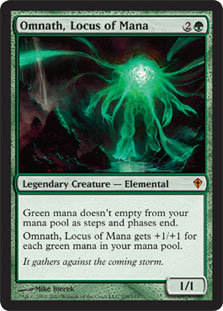
The next card on the agenda, Omnath, Locus of Mana, is one of the more hyped cards in the set. Aside from the tricky-dicky maneuvers you can pull off, taking advantage of his ability to change size at the speed of a mana source or act as an Upwelling that can knock you upside your head, Omnath draws people to the promise of how big he can grow, and how fast. On top of this, dreams of using all this Green mana when someone kills him dance around in many heads.
Do I think he has what it takes? Honestly, my intuition is that Omnath is the Wake Thrasher, or the Manaplasm, of the set. I am sure he will have some fringe uses (not to mention a whole lot of EDH), but overall, I got this guy at “Overrated.”
Everflowing Chalice
0
Artifact (uncommon)
Multikicker 2
Everflowing Chalice enters the battlefield with a charge counter on it for each time it was kicked.
T: Add 1 to your mana pool for each charge counter on Everflowing Chalice.
Michael Flores received a little bit of flack from readers that questioned his advocating what some have called “a bad Signet.” Frankly, I think that these people are somewhat foolish and this card is probably not for them (it’s for Spike). I actually agree with Flores 100% on this one. This will be a tournament staple, and will actually be quite good.
Do you have any idea how many times Rubin, Nassif, and I would be sitting in a circle and Nassif would just ask us for 14th time, “What are the Signets in Standard right now?” No, Gab, there are none…Until now.
I think that even if it really was just a Mind Stone you couldn’t sacrifice, I think it would still see play. The beauty is that Everflowing Chalice provides a great way to sink extra mana for added value, which then gives you a bunch of extra mana for cards like Mind Spring, Martial Coup, and all your Multikicker cards from Worldwake. In addition, Everflowing Chalice for one often leads to a Chalice for two or three. A Chalice for two or three often leads to a Chalice for four. This card may end up leading to a sort of modern day “Tron” strategy. I think this one will be a tournament staple. As a side note, the interaction between Vampire Hexmage and Everflowing Chalice should be kept in mind.
Tectonic Edge
Land (uncommon)
Add to your mana pool.
1,T, Sacrifice Tectonic Edge: Destroy target nonbasic land. Activate this ability only if an opponent controls four or more lands.
Strip Mine 2.0? Okay, sure, it costs a mana to use and it can never mana screw someone completely, but this one has chances of being a reasonable card, especially for mono-color decks, even some two-color decks. Just think, if you are playing a White Weenie deck, it is perfectly reasonable to have some colorless lands (now that you don’t have Mutavault). Playing this land doesn’t slow you down at all, but it does mean one more turn before your opponent can start Cruel Ultimatuming, as well as various other plays such as Baneslayer Angel or Martial Coup.
Tectonic Edge is also a particularly potent way to combat manlands, especially since by the time anyone activates a manland they have enough land on the battlefield to make your Strip Mine live. In addition, they are probably spending quite a bit more mana on their land than you are. Personally, I think this card will be very underrated at first and will turn out to be the only thing keeping these insane man-land dual lands in check. For sure, no shortage of players will misbuild their decks, week after week, not taking into consideration that this card actually does make it harder to play expensive spells.
Speaking of the new manlands, let’s look at the bunch of them:

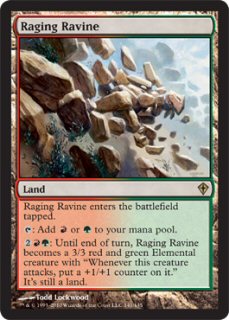
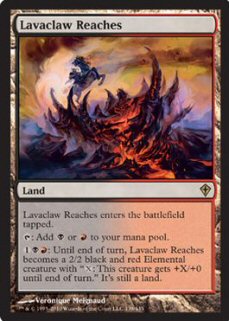
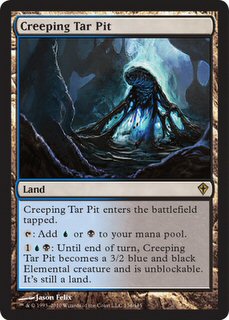
Thanks to Planemtg.de and Quiet Speculation for additional spoiler love on the manlands. The Green-White one is not confirmed yet, but the word on the street is that it is a 3/4 with reach when you pay 1GW. As you can see, they are all totally sick. The key to properly evaluating these cards is to remember that there is so little opportunity cost with them. For a detailed explanation on why I think the manland dual lands are super sweet, check here.
It’s not just the U/W one that is awesome, though. I think that every color that can use them will love to have an opportunity to pack extra threats into their deck while fixing their mana. These guys offer yet another opportunity to use all your mana every turn. The fact that everybody but the mono-color players will use these means that Goblin Ruinblaster is going to skyrocket in terms of its utility.
The manlands provide extra ways to kill Planeswalkers, anti-sweeper technology, more ways to justify playing more lands to hit additional landfalls, and I’ll tell you what, the average number of manlands in all Japanese decks these season will be right around 6. Just saying…
I like the Blue-Black one, since it is unblockable, for combating Jace (and other Planeswalkers). I like the Red-Green and Red-Black since those color combinations really want another dual land anyway, and they both let you sink all your mana. Remember the Red-Green one can be pumped as many times as you like in one turn (if you have a million mana), and the Red-Black one looks like it hits less hard than the rest, but the fact that it can be pumped through the roof means that every single one threatens to be a game ender in a stalemate, particularly if a Duress type effect has resolved. I particularly like this one with the Everflowing Chalice.
There are so many more cards I want to talk about, as this set is totally incredible, but I gotta wrap it up for this week. If you see additional cards that you have specific questions about, by all means, feel free to ask in the forums. Have fun at the prerelease this weekend (especially if you are hanging out in LA with me!).
See ya next week!
Patrick Chapin
“The Innovator”

